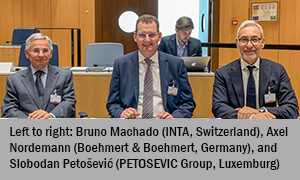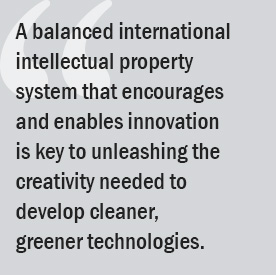INTA Attends WIPO Session on Copyrights; Protection of Broadcasters’ Rights Enters Decisive Phase
Published: May 1, 2019
 At the 38th Session of the World Intellectual Property Organization’s (WIPO’s) Standing Committee on Copyright and Related Rights, in Geneva, Switzerland, INTA members were on hand to audit the discussion of recent trademark developments. Dr. Axel Nordemann (Boehmert & Boehmert, Germany) and Slobodan Petosevic (PETOSEVIC Group, Luxemburg) attended the first two days of the session, which took place April 1‒5.
At the 38th Session of the World Intellectual Property Organization’s (WIPO’s) Standing Committee on Copyright and Related Rights, in Geneva, Switzerland, INTA members were on hand to audit the discussion of recent trademark developments. Dr. Axel Nordemann (Boehmert & Boehmert, Germany) and Slobodan Petosevic (PETOSEVIC Group, Luxemburg) attended the first two days of the session, which took place April 1‒5.
Although INTA participated in the meeting as an observer, the Secretariat was provided with the Association’s “Introductory Statement of INTA Before the Standing Committee on Copyright and Related Rights of WIPO,” outlining the Association’s interests in copyright developments, as shown below:
INTA’s Copyright Committee is comprised of both leading outside counsel and preeminent senior in-house counsel from companies all over the world. It has become a critical part of INTA’s mission. INTA has extended its scope to include copyright law because it has become increasingly clear that intellectual property issues do not present themselves in neat categories in the real world. To the contrary, it would not be unusual for a party to seek to protect its brand by bringing trademark claims based on a word mark and copyright claims based on infringement of its logo, product packaging, or advertising content.
 Moreover, INTA asserts that copyright and trademark law are indeed two separate legal doctrines with different histories, purposes and remedies; consequently, an original creative work of art, such as a logo, which acts as a source-identifier worthy of trademark protection, should also qualify to receive copyright protection. Also, since the Berne Convention for the Protection of Literary and Artistic Works promotes the position that copyright protection shall be granted without any formalities so that creators can more easily obtain copyright protection for their works, INTA has taken the position that, contrary to now-current case law, United States Courts should allow a copyright claimant to file and prosecute a copyright infringement suit without awaiting the issuance of a registration certificate or refusal from the Copyright Office.
Moreover, INTA asserts that copyright and trademark law are indeed two separate legal doctrines with different histories, purposes and remedies; consequently, an original creative work of art, such as a logo, which acts as a source-identifier worthy of trademark protection, should also qualify to receive copyright protection. Also, since the Berne Convention for the Protection of Literary and Artistic Works promotes the position that copyright protection shall be granted without any formalities so that creators can more easily obtain copyright protection for their works, INTA has taken the position that, contrary to now-current case law, United States Courts should allow a copyright claimant to file and prosecute a copyright infringement suit without awaiting the issuance of a registration certificate or refusal from the Copyright Office.
The Introductory Statement was presented before WIPO members, including Sylvie Forbin, Deputy Director General, WIPO Copyright and Creative Industries; Michele Woods, Director, WIPO Copyright and Creative Industries Sector; and Shira Perlmutter, Chief Policy Officer and Director for International Affairs of the U.S. Patent and Trademark Office.
Substantive questions on the session’s agenda concerned:
- Protection of broadcasting organizations;
- Limitations and exceptions for libraries and archives; and
- Limitations and exceptions for educational and research institutions and for persons with other disabilities.
Broadcast Protections
By far the most critical topic addressed was the protection of broadcasting organizations, as defined by a WIPO Broadcasters’ Treaty. After more than 20 years of discussion by WIPO, the topic now appears to be entering a decisive phase.
Outstanding issues include the following:
- What should actually be protected? Webcasting (broadcasting over Internet) appears to be the most problematic aspect of this question.
- How should broadcast signals be protected? Broadcasters want to outlaw the breaking of anti-piracy locks on digital signals. But critics argue that this could block legal use of TV broadcasts-such as material for personal and educational-and inhibit technological innovation.
- What further rights should be given to broadcasters? Broadcasters want to prevent unauthorized transmission of their programs over the Internet. Currently, they have exclusive rights for 20 years to authorize rebroadcasting, recording rights, reproduction, and communication to the public. Although some countries have adequate legislation in this regard, in much of the world it remains legal to retransmit a broadcast over the Internet without permission.
For example, while the broadcast of a concert featuring Beethoven’s Fifth Symphony would be protected, the symphony itself would remain in the public domain for others to play, record, or broadcast. However, broadcasters argue that they need to protect the broadcast itself, which can involve significant investment in infrastructure as well as the purchase of broadcasting rights.
- Important related questions
- What should be the limitations and exceptions to this protection?
- How long should this protection last?
Although every effort has been made to verify the accuracy of items in the INTA Bulletin, readers are urged to check independently on matters of specific concern or interest.
© 2019 International Trademark Association